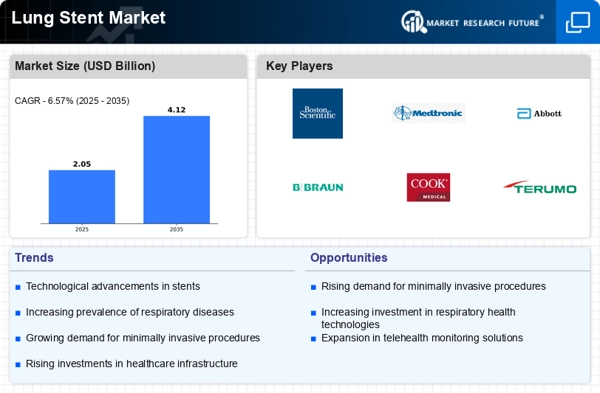Growing Focus on Preventive Healthcare
There is a notable shift towards preventive healthcare, which is impacting the Lung Stent Market. As awareness of lung health increases, more individuals are seeking early diagnosis and treatment for respiratory issues. This proactive approach is likely to lead to an uptick in procedures involving lung stents, as patients and healthcare providers prioritize interventions that can prevent disease progression. Furthermore, public health initiatives aimed at reducing smoking rates and improving air quality are expected to contribute to a healthier population, thereby influencing the demand for lung stents. The Lung Stent Market may see growth as a result of this evolving healthcare landscape.
Rising Incidence of Respiratory Diseases
The increasing prevalence of respiratory diseases, such as chronic obstructive pulmonary disease (COPD) and lung cancer, is a primary driver of the Lung Stent Market. According to recent data, respiratory diseases account for a significant portion of global morbidity and mortality. The World Health Organization indicates that COPD alone affects millions worldwide, leading to a growing demand for effective treatment options. Lung stents are increasingly recognized for their role in managing airway obstructions, thereby enhancing patient quality of life. As healthcare providers seek innovative solutions to address these challenges, the Lung Stent Market is likely to experience substantial growth, driven by the need for advanced therapeutic interventions.
Technological Innovations in Stent Design
Technological advancements in stent design and materials are transforming the Lung Stent Market. Innovations such as drug-eluting stents and bioresorbable materials are enhancing the efficacy and safety of lung stenting procedures. These advancements not only improve patient outcomes but also reduce the risk of complications associated with traditional stents. The introduction of minimally invasive techniques has further propelled the adoption of lung stents, as they offer quicker recovery times and less postoperative discomfort. As manufacturers continue to invest in research and development, the Lung Stent Market is poised for growth, with new products entering the market that cater to diverse patient needs.
Regulatory Support for Innovative Medical Devices
Regulatory bodies are increasingly supporting the development and approval of innovative medical devices, including lung stents, which is a key driver for the Lung Stent Market. Streamlined approval processes and incentives for manufacturers to develop advanced stenting solutions are fostering a conducive environment for market growth. This regulatory support not only accelerates the introduction of new products but also enhances patient access to cutting-edge treatments. As regulations evolve to accommodate technological advancements, the Lung Stent Market is likely to expand, driven by a continuous influx of innovative solutions that address unmet medical needs.
Aging Population and Increased Healthcare Expenditure
The aging population is a significant factor influencing the Lung Stent Market. As individuals age, the likelihood of developing respiratory conditions increases, leading to a higher demand for lung stenting procedures. Additionally, rising healthcare expenditure in many regions is facilitating access to advanced medical technologies, including lung stents. According to recent statistics, healthcare spending is projected to rise, allowing for better investment in respiratory care. This trend suggests that the Lung Stent Market will benefit from an expanding patient base and increased funding for innovative treatment options, ultimately driving market growth.

















Leave a Comment